This was published 1 year ago
Who really runs the country? The secret roles of Albanese’s ministers
Anthony Albanese’s ministers have portfolios – they also have other roles: confidantes, influencers, attack dogs. And some are more equal than others.
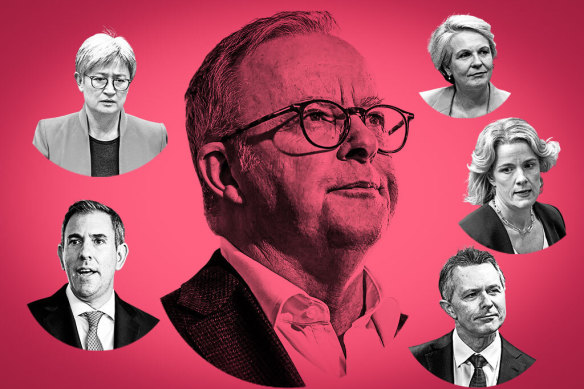
Credit: Marija Ercegovac
Two years after the election of Anthony Albanese’s government, the prime minister has not lost a single minister to scandal, retirement or incompetence.
But it has also become clear that some ministers are more equal than others. Looking beyond their ministerial day jobs, here are the people Albanese turns to for advice and problem-solving – and a couple who are running their own show.
The brains trust
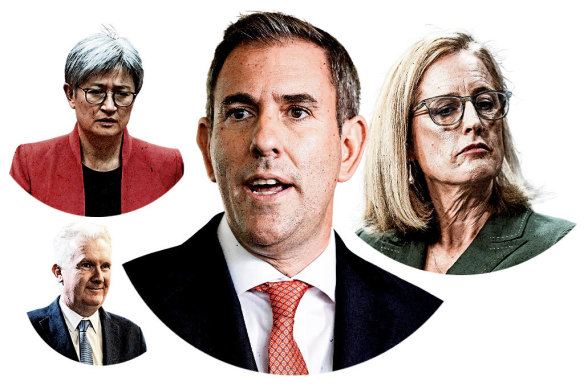
Credit: Marija Ercegovac
Foreign Affairs Minister Penny Wong is one of the government’s best-performing ministers. She is loved by the Labor faithful and has carefully repaired connections with Pacific and South-East Asian neighbours while thawing relations with Beijing. Wong’s handling of the Israel-Hamas war has not been perfect, however, and she has shown a distinct lack of interest in Europe. But her most important job is the one you don’t see publicly – the veteran South Australian senator is Albanese’s closest political confidante and, often, the first person he turns to for advice.
Katy Gallagher, the minister for finance, women and the public service, has perhaps the broadest portfolio responsibilities of anyone other than Albanese. After Wong, Gallagher has arguably the most “in the room” influence on the tone and direction of the government, and she has the ear of the PM. Dubbed the co-deputy prime ministers by some in the caucus, the pair sits on the powerful expenditure review and national security committees of cabinet (known as the ERC and NSC), wield covert influence and play an important role in taking the fight to the opposition.
Treasurer Jim Chalmers is one of the government’s best communicators. While he is not as tight with Albanese as Wong and Gallagher, he has formed a powerful duo with the finance minister and helped steer Labor towards consecutive budget surpluses. Albanese and Chalmers might go a couple of days without talking, but will then speak six times in one day to exchange notes. Chalmers sits on the ERC and NSC, too, and is viewed as the person most likely to succeed Albanese one day – he is quietly biding his time and building his credentials. Importantly, he is the most senior Queenslander in a state where the party is desperate to win more seats.
Tony Burke’s day job is minister for employment, workplace relations and the arts, but it’s his other job – leader of the House – that places him firmly in the government’s brains trust. In this role, Burke plays a big role in determining when legislation is brought forward and votes are called, and ensuring the government has command of the House in question time. He works closely with Albanese, himself a former leader of the House, in ensuring parliament runs smoothly. And although Burke is not on the ERC, he has another important job that he’s handled with aplomb so far – delivering union-friendly industrial relations laws that keep the party’s industrial base happy.
Covert influencers
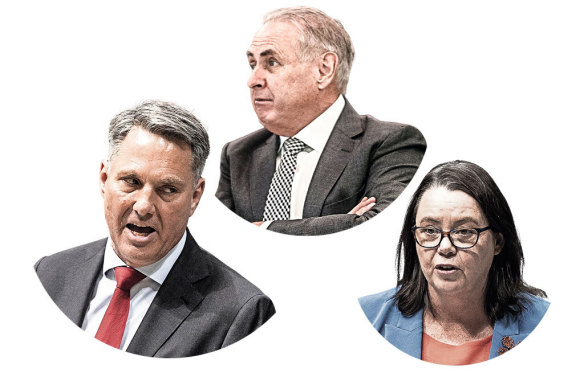
Credit: Marija Ercegovac
Trade Minister Don Farrell has played a big role in restoring trade with China, which is of major importance to Australian exporters. He failed to land a trade deal with the European Union, but for the right reasons: it wasn’t good enough. But Farrell’s biggest influence is behind the scenes as a steady hand, advocate for policy focused on middle Australia and, most of all, as the head of the “small states” Right faction. He has MPs loyal to him in every state and territory and his support for Albanese is vital.
Deputy Prime Minister and Defence Minister Richard Marles has been a solid performer and kept a low profile in what can be a tricky portfolio for Labor. Marles is closer to the PM than people realise and, along with Albanese, bedded down Australia’s commitment to the AUKUS submarine deal despite the objections of some Labor faithful. Marles is the only other MP who sits on the ERC and NSC and serves as a Right faction gatekeeper in Victoria for Albanese.
Resources Minister Madeleine King, much like her former boss and predecessor in the West Australian seat of Brand, Gary Gray, is a low-profile cabinet minister. But she matters as she is the most senior WA MP, and Labor is desperate to hang on to the swag of seats it won in the state in 2022. King is a strong advocate in cabinet for the resources sector, which can sometimes be a lonely task in a Labor government, but it’s core business for her home state.
As members of the ERC, ministers Michelle Rowland, Catherine King, Mark Butler and Stephen Jones all get an honourable mention, as do Mark Dreyfus and Chris Bowen as members of the NSC.
Running their own show
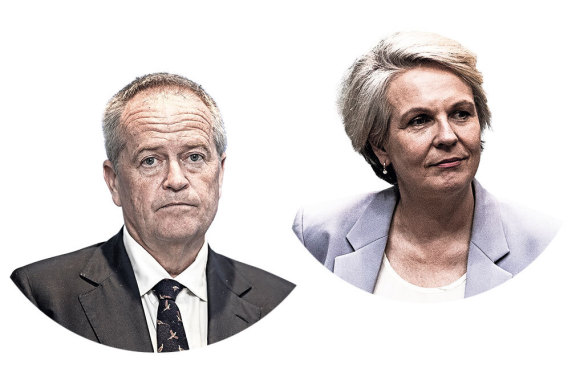
Credit: Marija Ercegovac
Bill Shorten has licence to roam across portfolios after six years leading the party, and he’s an accomplished performer. His desire to reform the National Disability Insurance Scheme, which he championed as a junior minister in the Rudd and Gillard governments, is genuine. If he can pare back its rapid growth rate and put it on a sustainable footing, it will be a singular legacy item. Although Shorten’s in the cabinet, he’ll never be “in the tent” while Albanese is leader and as such is allowed to run his own show.
Tanya Plibersek is a cut-through media performer and former deputy leader, so she’s allowed more freedom to run her own race. Though she isn’t in the inner circle of trust, she can land a killer blow on her political opponents. The difficult environment portfolio requires her to approve coal mines while representing one of the nation’s most left-wing, climate-friendly electorates.
Attack dogs and shutdown merchants
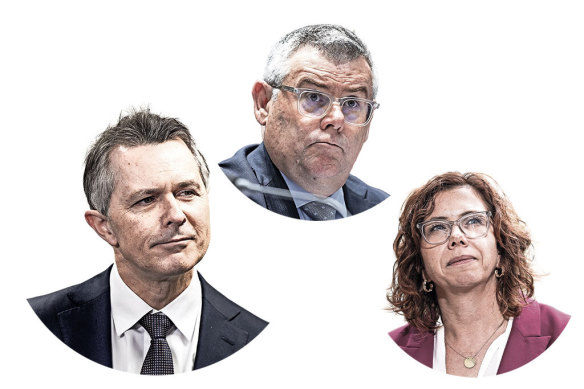
Credit: Marija Ercegovac
Murray Watt is a close political ally of the PM and, along with ministers Pat Conroy and Andrew Giles and assistant minister Tim Ayres, is a member of Albanese’s Left faction Praetorian Guard. Watt, the agriculture and emergency management minister, is often the man sent to speak outside his portfolio, put out political spot fires and shut down an issue. His input on Labor’s hunt for Queensland seats will be crucial if the party is to make gains up north. On track for promotion.
Education Minister Jason Clare had a spectacular 2022 election as the temporary face of the campaign when Albanese got COVID-19, but has since seemed to retreat into his shell. Juggling school funding deals with the states and an even bigger fight with universities over cuts to the number of foreign students, he is still sent occasionally to speak outside his portfolio – such as the instant response to Opposition Leader Peter Dutton’s budget reply speech – and take the fight to the opposition.
Social Services Minister Amanda Rishworth has a portfolio that can make news for the wrong reasons, such as problems with pension payments or the low rate of JobSeeker. A patient explainer in the media, Rishworth controls about one-third of the $700 billion federal budget and has delivered two successive rises in rent assistance and an increase in JobSeeker payments – decisions that pleased the party faithful and the sector, even if they may have wanted more. She’s also the person the prime minister relies on to be the caring voice of government, anchoring the 10-year plan to tackle domestic violence.
The lone wolf
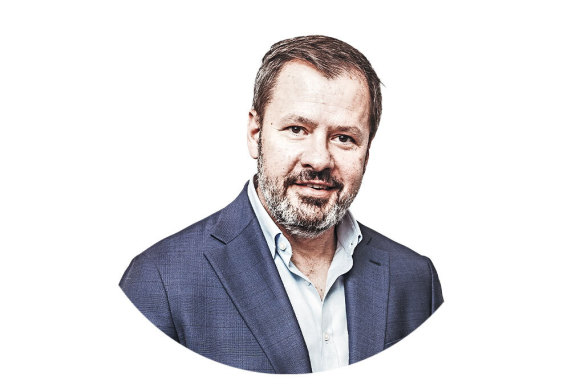
Credit: Marija Ercegovac
Ed Husic is one of the government’s best plain-speaking communicators and Labor’s Future Made in Australia agenda has made his industry and science portfolio more high-profile than usual. But while Husic is in the tent, unlike Shorten and Plibersek, he functions as a sort of pressure release valve for the backbench. That’s because he is not afraid to put a dissenting view in cabinet or speak out publicly on issues such as Gaza. This is a rare trait in a ministry, and a caucus, that has been well-behaved to the point of being supine for two years.
Next into cabinet
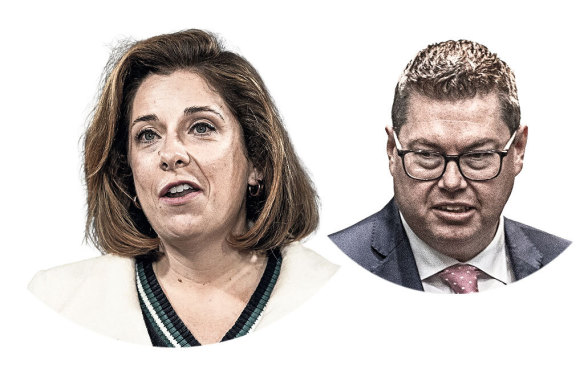
Credit: Marija Ercegovac
Defence Industry and Pacific Minister Pat Conroy has one of the toughest portfolios in government. He is hard-working, thrives on political combat, has travelled widely to repair relationships in the Pacific, and is across the fine details of his portfolio. He’s not universally liked at Defence HQ, but that’s not a bad thing, and although he is a junior minister, he has a spot on the NSC.
Anika Wells, the minister for aged care and sport, is one of the youngest members of the outer ministry and is highly rated by the PM. She has seized her opportunity with both hands, pushing for reforms to the aged care sector including better food for residents, more in-home care and more nurses – which she hasn’t quite landed yet. She has more to do, including putting funding for the sector on a sustainable footing, which will be a huge job.
Poisoned chalice
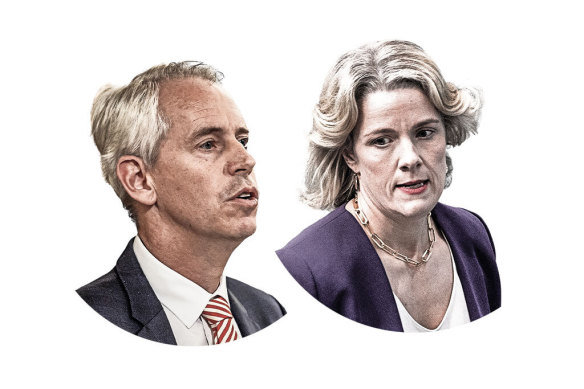
Credit: Marija Ercegovac
Clare O’Neil and Andrew Giles have the most thankless task in a Labor government – flak catchers for the prime minister in the terminally difficult home affairs and immigration portfolios. Both are talented ministers who have endured a torrid time since the High Court ruled indefinite immigration detention unlawful. Their public personas couldn’t be more different – O’Neil is a political warrior who relishes verbal combat (she sits on the NSC), whereas Giles prefers patient explanation. Neither approach is working perfectly currently and Labor has been marked down by voters on border protection and immigration in recent months.
Cut through the noise of federal politics with news, views and expert analysis. Subscribers can sign up to our weekly Inside Politics newsletter.